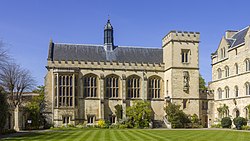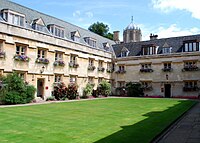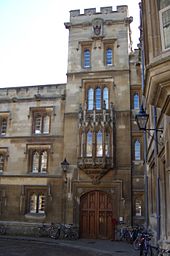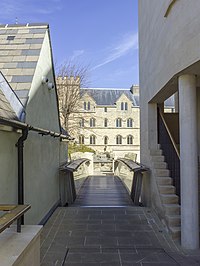Pembroke College, Oxford
| Pembroke College Latin: Collegium Pembrochianum
| |||||||||||||||||||
 Pembroke College Hall over the Chapel Quad | |||||||||||||||||||
|---|---|---|---|---|---|---|---|---|---|---|---|---|---|---|---|---|---|---|---|
 | |||||||||||||||||||
| Master: | Sir Ernest Ryder | ||||||||||||||||||
| Website: | pmb.ox.ac.uk | ||||||||||||||||||
| |||||||||||||||||||
| Location | |||||||||||||||||||
| Grid reference: | SP51330597 | ||||||||||||||||||
| Location: | 51°45’0"N, 1°15’28"W | ||||||||||||||||||
Pembroke College, a constituent college of the University of Oxford, located at Pembroke Square, Oxford. The college was founded in 1624 by King James I, using in part the endowment of merchant Thomas Tesdale, and was named after William Herbert, 3rd Earl of Pembroke, Lord Chamberlain and then-Chancellor of the University.
Like many Oxford colleges, Pembroke previously accepted men only, admitting its first mixed-sex cohort in 1979. As of 2020, Pembroke had an estimated financial endowment of £63 million.[1] Pembroke College provides almost the full range of study available at Oxford University.
History
Foundation and origins
In 1610, Thomas Tesdale on his death gave £5,000 for the education of Abingdon School Scholars (seven fellows and six scholars) at Balliol College, Oxford. However, in 1623, this money was augmented by the Reverend Richard Wightwick, parish priest of East Ilsley, and used instead for the conversion of Broadgates Hall into Pembroke College.[2][3] Broadgates Hall had been an academic hall for law students. The site of the hall was given to the Priory of St Frideswide by a Richard Segrim in 1254.[4] The letters patent founding the college were signed by King James I in 1624, it being named after William Herbert, 3rd Earl of Pembroke, Lord Chamberlain, Chancellor of the University, and a patron of William Shakespeare.[5]
Buildings


Old Quad
Following its foundation, the college proceeded to expand around Broadgates, building what is now known as "Old Quad" in the 1600s. Built in stages through the seventeenth century out of the local Cotswold limestone, space restrictions saw the south-side of the Quad built directly on top of the old City Wall.[6]
Chapel Quad
A Chapel was built in 1732, and the introduction of further accommodation in 1846, and the Hall in 1848 to designs by Exeter-based architect John Hayward[7] created "Chapel Quad." The Chapel was designed and built by William Townsend, although the interior was dramatically revamped by Charles Kempe—a Pembroke graduate—in 1884. Pembroke alumnus Dr. Damon Wells was a significant benefactor of the college over many years: he enabled the restoration of the Chapel in 1972 and provided ongoing support to the Chaplaincy and History Fellowship.[8] The Chapel which is still used for regular worship bears his name.[9]
North Quad
Further expansion of the College came in the 1960s, after the closure of Beef Lane to the north of Chapel Quad. The private houses north of the closed road were acquired by the college in a piecemeal fashion and reversed so that access was only possible from the rear. The area is now known as "North Quad" and was formally opened in 1962.
Rokos Quad

In April 2013 HRH The Duke of Kent]] officially opened a new quadrangle named after the lead donor Chris Rokos[10] The new buildings include a 170-seat multi-purpose auditorium, a new café, art gallery, and teaching and function rooms. The development is physically joined to the college's existing city-centre site via a new bridge crossing Brewer Street and the original mediæval city wall, and 'landing' in the old Fellows' Garden adjacent to Chapel Quad.
Outside links
| ("Wikimedia Commons" has material about Pembroke College, Oxford) |
References
- ↑ "Annual Report and Financial Statements" (in en). https://www.pmb.ox.ac.uk/sites/default/files/pembroke_college_annual_report_and_financial_statements_31st_july_2019_04.12.19.pdf.
- ↑ John Platt, ‘Tesdale, Thomas (bap. 1547, d. 1610)’, Oxford Dictionary of National Biography, Oxford University Press, 2004, accessed 30 January 2013]
- ↑ "Richard Wightwick – National Portrait Gallery". https://www.npg.org.uk/collections/search/person/mp55743/richard-wightwick.
- ↑ A History of the County of Oxford - Volume 3 pp 288-297: Pembroke College (Victoria County History)
- ↑ "Portrait of William Herbert, 3rd Earl of Pembroke, 1617". https://www.bl.uk/collection-items/portrait-of-william-herbert-3rd-earl-of-pembroke-1617.
- ↑ "Oxford City Wall". http://www.oxfordhistory.org.uk/city_wall/map.html.
- ↑ Oxford: an architectural guide, Geoffrey Tyack. ISBN 0-19-817423-3, ISBN 978-0-19-817423-3
- ↑ "Dr Damon Wells Hon CBE, Honorary Fellow – Pembroke College, University of Oxford". 18 October 2021. https://www.pmb.ox.ac.uk/news/dr-damon-wells-hon-cbe-honorary-fellow.
- ↑ "Chapel History – Pembroke College, University of Oxford". http://www.pmb.ox.ac.uk/College/The_Chapel/Chapel_History.php.
- ↑ "Pembroke Undergraduates Support Cutting-Edge Research Through Inaugural Rokos Awards Internships". pmb.ox.ac.uk. https://www.pmb.ox.ac.uk/news/pembroke-undergraduates-support-cutting-edge-research-through-inaugural-rokos-awards.
| Colleges of the University of Oxford | |
|---|---|
| Colleges:
All Souls • Balliol • Brasenose • Christ Church • Corpus Christi • Exeter • Green Templeton • Harris Manchester • Hertford • Jesus • Keble • Kellogg • Lady Margaret Hall • Linacre • Lincoln • Magdalen • Mansfield • Merton • New College • Nuffield • Oriel • Pembroke • The Queen's • Reuben • St Anne's • St Antony's • St Catherine's • St Cross • St Edmund Hall • St Hilda's • St Hugh's • St John's • St Peter's • Somerville • Trinity • University • Wadham • Wolfson • Worcester |
 |
| Permanent private halls:
Blackfriars • Campion Hall • Regent's Park College • St Benet's Hall • St Stephen's House • Wycliffe Hall | |
